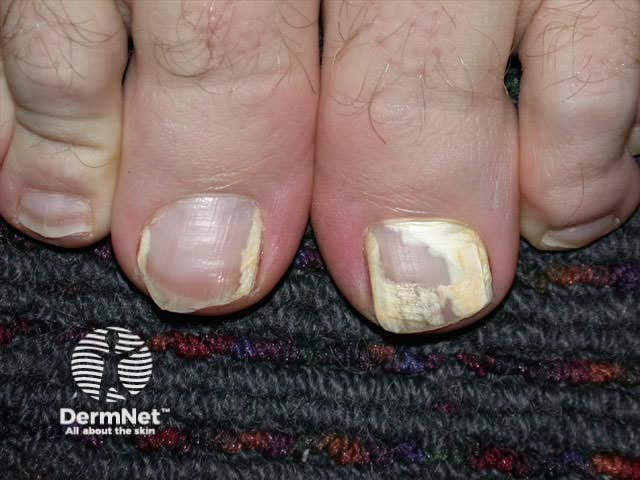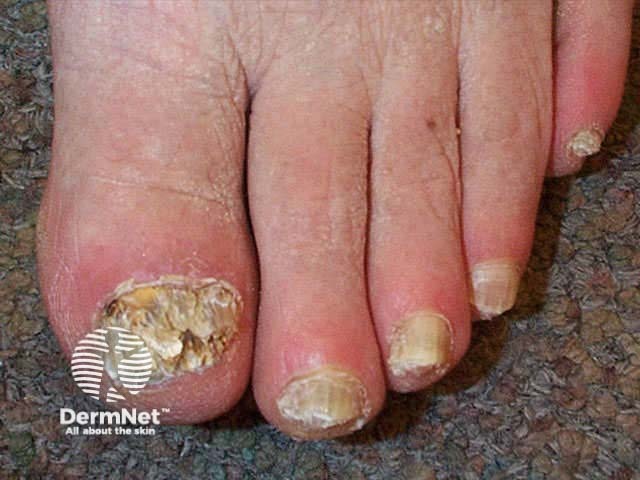Main menu
Common skin conditions

NEWS
Join DermNet PRO
Read more
Quick links
Tinea unguium
Created 2009.
Learning objectives
- Identify and manage tinea unguium
Clinical features
Tinea unguium is most often due to Trichophyton rubrum and T. interdigitale. It should be distinguished from other causes of onychomycosis:
- Candida species, which often cause paronychia
- Moulds including Scopulariopsis brevicaulis, Fusarium spp., Aspergillus spp., Alternaria, Acremonium, Scytalidinum dimidiatum and Scytalidinium hyalinum
Tinea unguium is increasingly prevalent with increased age and spreads from tinea pedis or less often, tinea manuum. It may affect one or more toenails and/or fingernails and most often involves the great toenail or the little toenail. It is often confused with non-infected nail dystrophy due to skin disease, particularly psoriasis (also dermatitis, lichen planus, viral warts, ageing changes).
It can present as several different patterns:
- Lateral onychomycosis. A white or yellow opaque streak appears at one side of the nail.
- Subungual hyperkeratosis. Scaling occurs under the nail.
- Distal onycholysis. The end of the nail lifts up. The free edge often crumbles.
- Superficial white onychomycosis. Flaky white patches and pits appear on the top of the nail plate.
- Proximal onychomycosis. Yellow spots appear in the half-moon (lunula).
- Complete destruction of the nail.
Onychomycosis
Lateral onychomycosis Superficial white onychomycosis Total nail destruction due to fungal infection 


Onychomycosis may look similar to nail dystrophy due to trauma, psoriasis, lichen planus, aging changes and even melanoma. Fungal infection is quite common in damaged nails, so antifungal therapy does not always return the nail to normal even when culture is positive.
Nail clippings
Clippings should be taken from crumbling tissue at the end of the infected nail. The discoloured surface of the nails can be scraped off. The debris can be scooped out from under the nail.
Previous treatment can reduce the chance of growing the fungus successfully in culture so take the clippings before treatment is commenced:
- To confirm the diagnosis – antifungal treatment will not be successful if there is another explanation for the nail condition.
- To identify the responsible organism – moulds and yeasts may require different treatment from dermatophyte fungi.
Treatment
Mild infections affecting less than 80% of one or two nails may respond to topical antifungal medications but cure usually requires an oral antifungal medication. Fingernail infections are usually cured more quickly and effectively than toenail infections.
Effective drugs are expensive and treatment is not always indicated:
- The nail disease may not be due to fungal infection even when culture is positive
- The infection may be asymptomatic
- The patient may not wish to apply or swallow a medication
- The chance of failure is very high in the elderly
- Adverse effects of antifungal medications include severe allergy and death
- Drug interactions can be serious
Topical antifungals are used twice weekly for 6 -12 months for nail plate infections:
- Amorolfine (Loceryl™) nail lacquer
- Ciclopirox (Batrafen™) nail lacquer
Azole oral antifungals require specialist approval for subsidy. They should be avoided in pregnancy. The duration of therapy ranges from 6-12 weeks (fingernails) or 3-6 months (toenails):
- Terbinafine (Lamisil™, Terbafin™) 250mg tablets once daily
- Itraconazole (Sporanox™) 100mg capsules, 200mg once daily or 200mg bd for 7 days each month
Removal of the nail is rarely necessary but may be considered if there is total nail destruction. Surgical removal is unpleasant and painful. Chemical evulsion can be performed by applying urea paste under occlusion and repeating every few days as necessary. It may take many months for the nail to regrow.
Activity
Determine the prevalence of fungal infection of the toenails in your patients. Examine the feet of the next 20 adults that you see.
- How many have toenail abnormalities?
- Of these, how many are likely to be due to tinea unguium?
- How many have tinea pedis and / or athlete's foot?
- What concerns do the patients have?
References:
On DermNet:
Information for patients
Other websites:
- Medscape Reference: Onychomycosis
- Merck Manual Professional: Dermatophytoses
- Medscape CME:
Books about skin diseases:
See the DermNet bookstore
